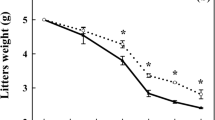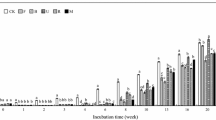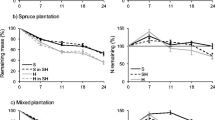Abstract
A decomposition experiment of Populus purdomii litter, a commonly used afforestation species in the Qinling Mountains, China, was conducted. Water extracts of five conifer litters were used to treat P. purdomii litter and its soil. The P. purdomii litter was incubated at room temperature (20–25 °C) and constant soil moisture for 6 months. During the decomposition period, the dynamics of litter mass and nutrient contents were detected to investigate the impacts of plant secondary metabolites. The results indicate that litter extracts of Pinus tabuliformis, Platycladus orientalis, Pinus armandii and Larix principis-rupprechtii significantly inhibited the overall nutrient release of P. purdomii litter, while the last three types of litter extracts simultaneously inhibited its decomposition. Conversely, the litter extracts of Picea asperata significantly accelerated the overall nutrient release of P. purdomii. Generally, most of the conifer species, whose litter released terpenoids , phenolics, steroids, and aliphatic acids, will inhibit the decomposition and/or nutrient release from P. purdomii litter. Their negative effects on the decomposers and soil enzymatic activities indicates that planting diversity should be lower when mixed planted with P. purdomii.

Similar content being viewed by others
References
Adamczyk S, Kiikkilä O, Kitunen V, Smolander A (2013) Potential response of soil processes to diterpenes, triterpenes and tannins: nitrification, growth of microorganisms and precipitation of proteins. Appl Soil Ecol 67:47–52
Adamczyk S, Adamczyk B, Kitunen V, Smolander A (2015) Monoterpenes and higher terpenes may inhibit enzyme activities in boreal forest soil. Soil Biol Biochem 87:59–66
Aderiye BI, Ogundana SK, Adesanya SA, Roberts MF (1989) The effect of β-sitosterol on spore germination and germ-tube elongation of Aspergillus niger and Botryodiplodia theobromae. Int J Food Microbiol 8:73–78
Bao S (2000) Soil agro-chemistrical analysis. China Agriculture Press, Beijing
Cañas AI, Alcalde M, Plou F, Martínez MJ, Martínez ÁT, Camarero S (2007) Transformation of polycyclic aromatic hydrocarbons by laccase is strongly enhanced by phenolic derivatives present in soil. Environ Sci Technol 41:2964–2971
Cesco S, Mimmo T, Tonon G, Tomasi N, Pinton R, Terzano R, Neumann G, Weisskopf L, Renella G, Landi L (2012) Plant-borne flavonoids released into the rhizosphere: impact on soil bio-activities related to plant nutrition. A review. Biol Fertil Soils 48:123–149
Chapman SK, Newman GS, Hart SC, Schweitzer JA, Koch GW (2013) Leaf litter mixtures alter microbial community development: mechanisms for non-additive effects in litter decomposition. PLoS ONE 8:e62671
Cho WI, Cheigh CI, Hwang HJ, Chung MS (2015) Sporicidal activities of various surfactant components against Bacillus subtilis spores. J Food Prot 78:1221–1225
Chomel M, Guittonny-Larchevêque M, Fernandez C, Gallet C, DesRochers A, Paré D, Jackson BG, Baldy V (2016) Plant secondary metabolites: a key driver of litter decomposition and soil nutrient cycling. J Ecol 104:1527–1541
Cox S, Mann CM, Markham JL, Bell HC, Gustafson JE, Warmington JR, Wyllie SG (2000) The mode of antimicrobial action of the essential oil of Melaleuca alternifolia (tea tree oil). J Appl Microbiol 88:170–175
De Marco A, Meola A, Maisto G, Giordano M, De Santo AV (2011) Non-additive effects of litter mixtures on decomposition of leaf litters in a Mediterranean maquis. Plant Soil 344:305–317
Enguita FJ, Leitão AL (2013) Hydroquinone: environmental pollution, toxicity, and microbial answers. Biomed Res Int 2013:e542168
Gartner TB, Cardon ZG (2004) Decomposition dynamics in mixed-species leaf litter. Oikos 104:230–246
Guan Z, Luo Q, Chen X, Feng X, Tang Z, Wei W, Zheng Y (2014) Saline soil enzyme activities of four plant communities in Sangong River basin of Xinjiang, China. J Arid Land 6:164–173
Hammer K, Carson C, Riley T (2003) Antifungal activity of the components of Melaleuca alternifolia (tea tree) oil. J Appl Microbiol 95:853–860
Hättenschwiler S, Jørgensen HB (2010) Carbon quality rather than stoichiometry controls litter decomposition in a tropical rain forest. J Ecol 98:754–763
Joanisse GD, Bradley RL, Preston CM, Munson AD (2007) Soil enzyme inhibition by condensed litter tannins may drive ecosystem structure and processes: the case of Kalmia angustifolia. New Phytol 175:535–546
Kong C, Wang P, Zhao H, Xu X, Zhu Y (2008) Impact of allelochemical exuded from allelopathic rice on soil microbial community. Soil Biol Biochem 40:1862–1869
Li L, Li T, Zang J, Chen B, Liu W, Wu Z (2013) The effect of biochar on soil enzyme activity, microbial community structure and soil nutrient content in the soil amended with cinnamic acid. Acta Agric Boreali-Sin 28:210–216
Li Q, Wang X, Lin J, Liu J, Jiang M, Chu L (2014a) Chemical composition and antifungal activity of extracts from the xylem of Cinnamomum camphora. BioResources 9:2560–2571
Li Y, Ying Y, Zhao D, Ding W (2014b) Influence of allelochemicals on microbial community in ginseng cultivating soil. Chin Herbal Med 6:313–318. https://doi.org/10.1016/S1674-6384(14)60047-2
Li Q, Liu P, Tang Z, Zhao H, Wang J, Song X, Yang L, Wan S (2016) Effects of two phenolic acids on root zone soil nutrients, soil enzyme activities and pod yield of peanut. Chin J Appl Ecol 27:1189–1195
Li C, Han C, Ye S, Zhang X (2017) Influences of ferulic acid on Astragalus sinicus seedling growth, rhizosphere soil enzyme activity, microbial population and soil nutrient. Jiangsu Agric Sci 45:134–137
Liu Z, Duan E, Fu G, Cui F, Gao W (2007) A new concept: soil polarization in planted pure forest. Acta Pedologica Sin 44:1119–1126
Liu P, Liu ZH, Wang CB, Guo F, Wang M, Zhang YF, Dong L, Wan SB (2012) Effects of three long-chain fatty acids present in peanut (Arachis hypogaea L.) root exudates on its own growth and the soil enzymes activities. Allelopathy J 29:13–24
Lu Y, Xu J, Zhang X, Wang B, Xie B, Liu Z (2017) Effects of leachate from understory medicinal plants on litter decomposition and soil enzyme activities of Betula albo-sinensis and Eucommia ulmoides. Chin J Plant Ecol 41:639–649
Pattnaik S, Subramanyam V, Bapaji M, Kole C (1997) Antibacterial and antifungal activity of aromatic constituents of essential oils. Microbios 89:39–46
Roy R, Laskar S, Sen S (2006) Dibutyl phthalate, the bioactive compound produced by Streptomyces albidoflavus 321.2. Microbiol Res 161:121–126
Salamci E, Kordali S, Kotan R, Cakir A, Kaya Y (2007) Chemical compositions, antimicrobial and herbicidal effects of essential oils isolated from Turkish Tanacetum aucheranum and Tanacetum chiliophyllum var. chiliophyllum. Biochem Syst Ecol 35:569–581
Schimel JP, Hättenschwiler S (2007) Nitrogen transfer between decomposing leaves of different N status. Soil Biol Biochem 39:1428–1436
Seastedt T, Crossley D (1980) Effects of microarthropods on the seasonal dynamics of nutrients in forest litter. Soil Biol Biochem 12:337–342
Shao X, Cheng S, Wang H, Yu D, Mungai C (2013) The possible mechanism of antifungal action of tea tree oil on Botrytis cinerea. J Appl Microbiol 114:1642–1649
Shi B, Luan D, Wang S, Zhao L, Tao L, Yuan Q, Wang X (2015) Borneol-grafted cellulose for antifungal adhesion and fungal growth inhibition. RSC Adv 5:51947–51952
Skočibušić M, Bezić N, Dunkić V (2006) Phytochemical composition and antimicrobial activities of the essential oils from Satureja subspicata vis. growing in Croatia. Food Chem 96:20–28
Takemura T, Kamo T, Sakuno E, Hiradate S, Fujii Y (2013) Discovery of coumarin as the predominant allelochemical in Gliricidia sepium. J Trop For Sci 25:268–272
Triebwasser DJ, Tharayil N, Preston CM, Gerard PD (2012) The susceptibility of soil enzymes to inhibition by leaf litter tannins is dependent on the tannin chemistry, enzyme class and vegetation history. New Phytol 196:1122–1132
Tripathi S, Rawat K, Dhyani S, Pant H (2009) Potential of Lantana camara Linn. weed against wood destroying fungi. Indian For 135:403–411
Turner BL (2010) Variation in pH optima of hydrolytic enzyme activities in tropical rain forest soils. Appl Environ Microbiol 76:6485–6493
Yu D, Shao X, Xu F, Wang H (2014) Review on effects and mechanism of tea tree oil applied in fruit preservation. J Fruit Sci 31:313–319
Zhang Z, Qiao M, Li D, Zhao C, Li Y, Yin H, Liu Q (2015) Effects of two root-secreted phenolic derivatives from a subalpine coniferous species on soil enzyme activity and microbial biomass. Chem Ecol 31:636–649
Zheng Y (2008) Antibiotic functions and volatile organic compounds from Pinus tabulaeformis var. mukdensis Uyeki and Betula platyphlla Suk, Northeast Forestry University Harbin, China
Author information
Authors and Affiliations
Corresponding author
Additional information
Project funding: This research was supported by the Specialized Research Fund for the Doctoral Program of Yan’an University (YDBK2017-26), the Natural Science Basic Research Plan in Shaanxi Province of China (2018JQ4047), and the Young Talent fund of University Association for Science and Technology in Shaanxi, China (20170704).
The online version is available at http://www.springerlink.com
Corresponding editor: Yu Lei.
Electronic supplementary material
Below is the link to the electronic supplementary material.
Rights and permissions
About this article
Cite this article
Zhang, X., Wang, B. & Liu, Z. Impacts of plant secondary metabolites from conifer litter on the decomposition of Populus purdomii litter. J. For. Res. 30, 2237–2245 (2019). https://doi.org/10.1007/s11676-018-0766-7
Received:
Accepted:
Published:
Issue Date:
DOI: https://doi.org/10.1007/s11676-018-0766-7




